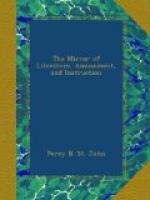Because a sixth of it is chromic acid, while other gems, as the garnet, are coloured by oxide of iron. The most esteemed, and at the same time, rarest colour, of the oriental ruby, is pure carmine, or blood-red of considerable intensity, forming, when well polished, a blaze of the most exquisite and unrivalled tint. It is, however, more or less pale, and mixed with blue in various proportions; hence it occurs rose-red and reddish white, crimson, peach-blossom red, and lilac blue—the latter variety being named oriental amethyst. A ruby perfect both in colour and transparency, is much less common than a good diamond, and when of the weight of three or four carats, is even more valuable than that gem. The king of Pegu, and the monarchs of Siam and Ava, monopolize the rarest rubies; the finest in the world is in the possession of the first of these kings: its purity has passed into a proverb, and its worth when compared with gold, is inestimable. The Subah of the Deccan, also, is in possession of a prodigiously fine one, a full inch in diameter. The princes of Europe cannot boast of any of a first rate magnitude. Mr. Mawe, from whose interesting work we abridge these particulars, considers the oriental sapphire to rank next in value to the ruby. Among the British crown jewels is an inestimable sapphire; it is of the purest and deepest azure, more than two inches long, and one inch broad. The finest ruby among these gems is more treasured for its antiquity than intrinsic value, it being the one worn at Cressy and Agincourt, by the Black Prince and Henry V.: this is worn on the back cross, and the sapphire on the front, of the imperial crown upon state occasions.
Why are garnets often found of a reddish brown tinge?
Because of the excess of oxide of iron which they contain; a small proportion being sufficient to colour them entirely, without injuring their play and splendour. In fact, the perfection of all gems depends less on the quality of their component principles, than on their complete solution and intimate combination. The alkalized earths, as lime, magnesia, and still better, pot-ash, seem to intervene as solvents, for alumina, completely dissolved, acquires, as we have shown from Klaproth, a crystallization, of which, by itself, it is not susceptible.
The garnet is found in Bohemia, Ceylon, and other countries; but the chief mart formerly being Sirian, the capital of Pegu, the best are often denominated Sirian garnets. The colour most esteemed is blood or cherry red, mixed often, however, with blue, forming tints of crimson, purple, and reddish violet; or orange red and hyacinth brown. The Sirian garnet is of a violet colour, which, in some rare specimens, makes it compete with the amethyst, from which it is to be discriminated by the disadvantage of losing its brilliancy, and acquiring an orange tint by candlelight. Distinct from all other garnets, it preserves its colour unmixed with the common black tinge, unassisted by foil, even when thick. Course garnets are used as emery for polishing metals, and by lapidaries. They are found in Ireland, in Norway, and many other countries.




